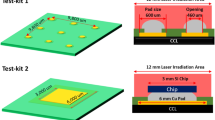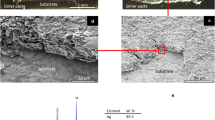Abstract
The use of local and rapid heating of electronic assemblies can significantly reduce the degradation of temperature-sensitive materials and substrate bowing commonly encountered in electronic applications during the high temperature reflow process. It can also allow assembling electronic packages on a non-planar surface and/or on massive structures that are very complex using a conventional oven for soldering. In order to attach electronic components to substrates, a rapid soldering process using an exothermic reactive foil sandwiched between solder preforms was evaluated. Once the film was activated and reacted, the solder preforms were melted to ensure the adhesion between the assembled materials. The effect of applied pressure on the joint quality, the reactive film thickness, as well as the attached material thickness and physical properties were assessed. Using a 60 μm thick reactive foil with two 25 μm thick SnAgCu305 preforms, results show that the fraction of void-free interfacial area between a metallized diode and an active metal braze substrate increased from 34% to 74% with pressure values between 0.5 kPa and 100 kPa, respectively. At a constant pressure of 13 kPa, increasing the reactive foil thickness from 40 μm to 60 μm leads to an increase in the void-free interfacial attach area ratio from 20% to 40%, and a value of 54% was achieved by using two 60 μm foils under the same conditions. The substrate metallization and solder thickness also affect the joint quality. The experimental results are analyzed and correlated with the duration of liquid solder using thermal models.
Similar content being viewed by others
References
S. Kyung-ah, L. Anna, L. Gerald, G. Manuel, H. Toshiro, H. Richard, S. Leif, and S. William, Nanosci. Nanotechnol. Lett. 2, 2 (2010).
T. Funaki, J. C. Balda, J. Junghans, A. A. Kashyap, F.D. Barlow, H. A. Mantooth, T. Kimoto, and T. Hikihara, IEICE Electron Express 1, 523 (2004).
V.R. Manikam and K.Y. Cheong, IEEE Trans. Compon. Packag. Manuf. Technol. 1, 4 (2011).
C. Buttay, A, Masson, J. Li, M. Johnson, M. Lazar, C Raynaud, and H. Morel, IMAPS High Temperature Electronics Network HITEN, pp. 1–7 (2011).
M. Knoerr, S. Kraft, and A. Schletz, in 12th Electronics Packaging Technology Conference (2010). https://doi.org/10.1109/eptc.2010.5702605.
S.J. Pearton, J.C. Zolper, R.J. Shul, and F. Re, J. Appl. Phys. 86, 1 (1999).
P. Neudeck, R. Okojie, and L. Chen, Proc. IEEE 90, 6 (2002). https://doi.org/10.1109/JPROC.2002.1021571.
R. Khazaka, L. Mendizabal, D. Henry, and R. Hanna, IEEE Trans. Power Electron. 30, 5 (2015).
P. Hagler, P. Henson, and R.W. Johnson, IEEE Trans. Ind. Electron. 58, 7 (2011).
J. Wang, E. Besnoin, O.M. Knio, and T.P. Weihs, J. Appl. Phys. 97, 114307 (2005).
R. Khazaka, L. Mendizabal, and D. Henry, J. Electron. Mater. 43, 7 (2014).
R. Khazaka, B. Thollin, L. Mendizabal, D. Henry, R. Khazaka, and R. Hanna, IEEE Trans. Device Mater. Rel. 15, 2 (2015).
M. Zenou, O. Ermak, A. Saar, and Z.Kotler, J.Phys. D Appl. Phys. 47, 025501 (2014).
S. Magdassi, M. Grouchko, and A. Kamyshny, Materials. (2010). https://doi.org/10.3390/ma3094626.
T. Wang, X. Chen, G.Q. Lu, and G.Y. Lei, J. Electron. Mater. 36, 10 (2007).
K. Schnabl, L. Wentlent, K. Mootoo, S. Khasawneh, A. Zinn, J. Beddow, E. Hauptfleisch, D. Blass, and P. Borgensen, J. Electron. Mater. 43, 12 (2014).
P. Świerzy, Y. Farraj, A. Kamyshny, and S. Magdassi, Colloids Surf. A 521, 272 (2017).
X. Yu, J. Li, T. Shi, C. Cheng, G. Liao, J. Fan, T. Li, and Z. Tang, J. Alloys Comp. 724, 365 (2017)
G.Q. Lu, W. Li, Y. Mei, G. Chen, X. Li, and X. Chen, IEEE Trans. Device Mater. Reliab. 14, 2 (2014).
W.C. Welch and K. Najafi, in IEEE International Conference on Micro Electro Mechanical Systems proceeding (2008). https://doi.org/10.1109/memsys.2008.4443779
T. Hu, H. Chen, M. Li, and Z. Zhao, IEEE Trans. Power Electron 32, 1 (2016).
J. Wang, E. Besnoin, O.M. Knio, and T.P. Weihs, J. Appl. Phys. 95, 1 (2004).
X. Qiu, Reactive Multilayer Foils and Their Applications in Joining, Master Thesis at Louisiana State University (2007).
R. Diehm, M. Nowottnick, and U. Pape, IPC APEX EXPO vol. 1, pp. 425–442 (2012)
J. Wang, E. Besnoin, O.M. Knio, and T.P. Weihs, Acta Mater. 52, 5235 (2004).
R. Dou, T. Ge, X. Liu, and Z. Wen, Int. J. Heat Mass Transf. 94, 156 (2016).
N. Zhao, X.M. Pan, D.Q. Yu, H.T. Ma, and L. Wang, J. Electron. Mater. 38, 6 (2009).
J. Chang, L. Wang, J. Dirk, and X. Xie, Weld. J. 85, 63 (2006).
Military Standard, Test Methods standard microcircuits, Mil-Std-883E Method 2030, Ultrasound inspection of die attach (1996).
K. Otiaba, R. Bhatti, N. Ekere, S. Mallik, E. Amalu, and M. Ekpu, in 3rd IEEE International Conference on Adaptive Science and Technology ICAST (2011).
Author information
Authors and Affiliations
Corresponding author
Rights and permissions
About this article
Cite this article
Khazaka, R., Martineau, D. & Azzopardi, S. Joining Using Reactive Films for Electronic Applications: Impact of Applied Pressure and Assembled Materials Properties on the Joint Initial Quality. J. Electron. Mater. 47, 7053–7061 (2018). https://doi.org/10.1007/s11664-018-6631-9
Received:
Accepted:
Published:
Issue Date:
DOI: https://doi.org/10.1007/s11664-018-6631-9




